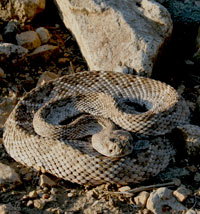
First aid for snake bite has ranged over the years from the ignorant (whisky, live-chicken poultices*) to the formerly accepted but now discounted (incision and suction, ice packs), to the hilariously irrelevant (“Wash the bite with soap and water”—American Red Cross) to outright quackery (electric shock). Since no one has as yet developed an antivenom suitable for field use by non-medical personnel, the single “treatment” recommended by all authorities is “Get the victim to a hospital”—which is okay if you’re two hours from a city and run afoul of a rattlesnake, not so okay if an eastern brown snake nails you two days from Alice Springs.
(*Cut open a live chicken and spread it over the bite to extract the venom. When the chicken’s comb turns blue, you’re cured.)
Part of the problem with first aid for venomous snake bites is the difference in venom. Speaking very broadly, viperids such as rattlesnakes, copperheads, and puff adders employ hemotoxic venom that breaks down blood and tissue; elapids such as cobras, mambas, taipans, tiger snakes—and that brown snake that just nailed you—produce neurotoxic venom that affects the central nervous system. Thus, antivenom for a cobra bite will have no effect on a copperhead bite. (Regional pride goads me to acknowledge our southwestern Mojave rattlesnake, populations of which boast a venom displaying both hemotoxic and neurotoxic effects.
Furthermore, field treatments for one type of venom can be contraindicated for another. Many neurotoxic venoms spread mainly through the body’s lymphatic system, and it has become accepted practice to wrap the bitten limb in a wide constricting band (not a tourniquet), which slows the spread and delays its impacts on the central nervous system. Do the same with a rattlesnake bite and you concentrate that tissue-destroying venom in one spot, greatly increasing the risk of amputation of the limb.
Now comes interesting news regarding a potentially effective first-aid treatment for certain elapid bites. A team led by physiologist Dirk van Helden, of the University of Newcastle in Australia (the only continent with more venomous than non-venomous snake species), has shown that applying an ointment containing nitroglycerin to the site of the bite significantly slows the spread of venom. The nitroglycerin produces nitric oxide gas, minuscule amounts of which are absorbed through the skin, where it inhibits pumping of the lymphatic vessels.
If further tests support the initial results, a tube of the ointment could be regarded as a potentially life-saving tool in the kit of Australian explorers—although getting to a hospital for proper antivenom treatment would still be critical. Two downsides have been noted so far: The ointment must be applied within a minute or so of the bite to provide efficacy, and it is only effective on venoms whose toxic protein molecules are too large to directly enter the bloodstream and be transported through the circulatory system. Thus the treatment would have little or no value for bites from such species as cobras and mambas.
We can hardly wait to see the ads for “Anti-snake-bite lotion!” Perhaps with an SPF factor as well? Hat tip to Science News, sciencenews.org.
